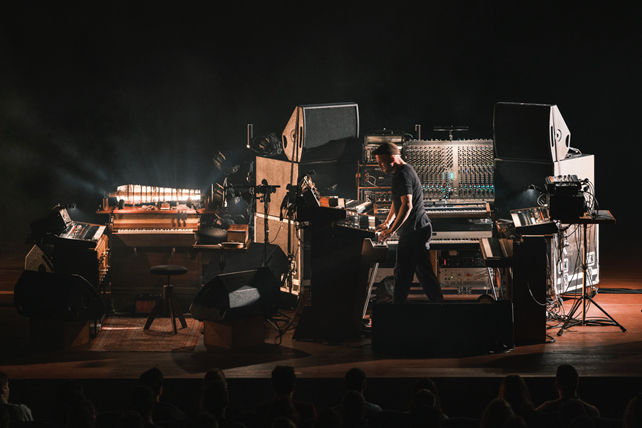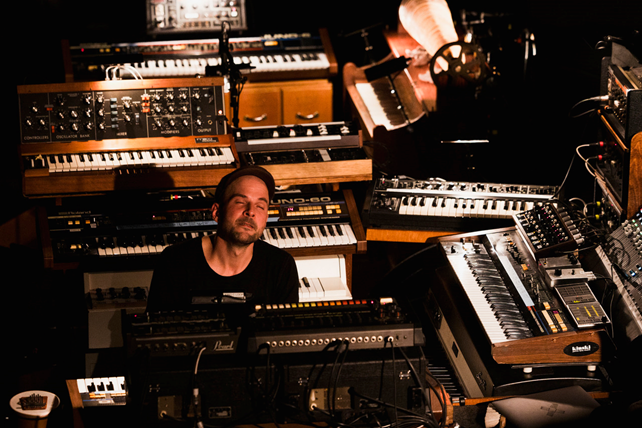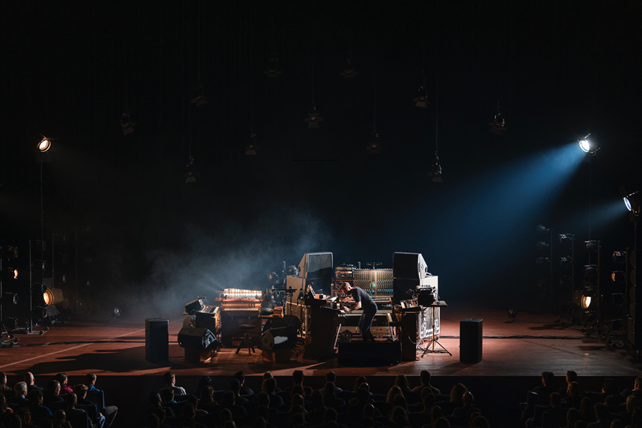There is a strange feeling while entering the Grand Auditorium at the Philharmonie on 2 March. The room is dark with some lights illuminating only the instruments on stage: a piano, keyboards, and a whole set of electronics. Then, on the left side there is a strange instrument that caught everyone’s attention. As soon as I saw it, the first thing I have in mind is to find out what it is.
It is called glass harmonica, a type of musical instrument that uses a series of glass bowls or goblets graduated in size to produce musical tones by means of friction (instruments of this type are known as friction idiophones). It was invented in 1761 by Benjamin Franklin.
When Benjamin Franklin invented the mechanical version of the instrument, he called it the armonica, based on the Italian word armonia, which means “harmony”. (Source: Wikipedia)
When Nils Frahm walks on stage and starts his concert by playing it, there is a feeling of peace and calm surrounding the whole Grand Auditorium. It is a beautiful, mystic sound, which reminds the organ played in a church.
This is Nils Frahm and this is how he introduced himself.
Nils Frahm had an early introduction to music, learning the piano throughout his childhood. It was through this that he began to immerse himself in the styles of classical pianists from previous generations as well as the music of contemporary composers, before forging his own musical path through composition.
Today Nils Frahm continues to work as an accomplished composer, producer, and celebrated performer from his Berlin-based studio at the renowned Funkhaus.
Following his first solo piano works in collaboration with cellist Anne Müller, his break-through album Felt was released on Erased Tape Records in 2011. In 2013, he released his second album Spaces, while in 2015 he launched “Piano Day”, an annual worldwide celebration of this instrument.
Among other projects, Nils Frahm has composed a collaborative film score with Woodkid for Ellis, a short film by French artist JR featuring spoken words by Robert De Niro, as well as contributed to James Gray’s Ad Astra starring Brad Pitt and to Julian Rosenfeldt’s Manifesto.
In October 2015, he celebrated his continued musical partnership with fellow artist Ólafur Arnalds with the release of their Collaborative Works and included their three previous EP releases Stare, Loon and Life Story Love and Glory, plus Trance Frendz — the audio recording of their intimate 45-minute studio film.
On 1st March 2024 he released Day, his latest album recorded in the summer of 2022 in complete solitude and away from his studio at Berlin’s famed Funkhaus complex. The album was preceded by Butter Notes, the first single.
After the forced lockdown due the Covid pandemic, Nils Frahm returned to the live stage for the first time since 2019 at the Sydney Opera House in June 2023 for the world premiere of his current global tour entitled “Music for”.
And here we are. Nils Frahm returns to the Philharmonie with “Music for Luxembourg”, after his first appearance during the 2019/2020 season.
His music is soothing, and while he is playing on stage, switching from the glass harmonica to the piano, to his electronic equipment or even to recording the audience after asking them to start imitating animal sounds, he is really connected to the people in the Grand Auditorium.
While using a lot of electronics in his performances, Nils Frahm has a strong view on the limits of technology applied to music. In March 2021, in an interview with The Independent, he declared: “I’m very surprised at how functional music has become: the music needs to be as boring as possible, so people forget about it. Because if it gets drastic, people might just not feel in the mood for it and skip it, and the algorithm [dictates that] a track which is skipped more than it is not will disappear into the void of nothing.” (Source: Nils Frahm: ‘NFTs are the most disgusting thing on the planet” – The Independent – 29 March, 2021).
He has a reverence for analogue equipments. In 2022, he published Music for Animals, a 3-hour album, conceived at the time of the pandemic and the result of a long, creative process.
The world of Nils Frahm is devoted to research the connections between the classical music world and electronic music, and between electronic music and the analogue world.
Do you remember what happened when Bob Dylan decided to plug in his guitar and went electric for the first time at the Newport Folk Festival in 1965? People thought that not only was he betraying his fans but also his music and himself as an artist.
One of the most acclaimed Bob Dylan’s songs is The Times They Are a-Changin’. When we talk about music, are we sure that the times are really changing? The fact is that there will always be people questioning if electronic music is “real” music and, most of the times, these will be people who had never listened to a single electronic music song.
The so called “purists” will always exist, but these people do not belong to modern and contemporary times. They belong to a past that does not exist anymore.
Nils Frahm shows that electronic music can connect people, as much as any other music genre. Electronic music has many faces, and he knows how to show them all to the whole world. Nils Frahm is the heart and soul of electronic music.




